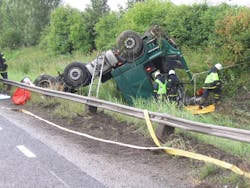I see the bad moon rising
I see trouble on the way
I see earthquakes and lightnin'
I see bad times today
–From “Bad Moon Rising” by Creedence Clearwater Revival (CCR)
Trucking is a business that often skates on some very thin ice at times – literally so during the winter months.
Take the recent decline in diesel fuel prices, for example. While that certainly reduces the amount of cash truckers pay out to fill their tanks, it doesn’t necessarily translate into a big boost for the bottom line as this story indicates.In a broader sense, though, risk is an every-present companion in the motor carrier industry. The list of potentially problematic situations is endless: bad weather, traffic congestion, vehicle crashes, dock delays, equipment failures, regulatory violations ... just take your pick.
Yet risks also abound in the “macro scenario” sense as well for truckers, in terms of cyberattacks, suddenly sluggish economic demand, and the like.
Allianz Global Corporate & Specialty conducts regular analysis of such “disruptive scenarios” and according to its fourth Allianz Risk Barometer 2015, so-called “traditional industrial risks” such as business and supply chain interruptions (46% of responses), natural catastrophes (30%), and fire and explosion (27%) continue to lead the “risk list.”
Yet the two most “significant movers” in terms of risk threats gleaned from a global poll of 500 business risk managers for this year are cyber (17%) and politically-related (11%) issues, the firm noted.“The growing interdependency of many industries and processes means businesses are now exposed to an increasing number of disruptive scenarios [for] negative effects can quickly multiply,” noted Chris Fischer Hirs (at left), Allianz’s CEO.
“One risk can lead to several others,” he stressed. “Natural catastrophes or cyberattacks can cause business interruption not only for one company, but to whole sectors or critical infrastructure. [Thus] risk management must reflect this new reality.”
Business interruption and supply chain issues still remain the top concern for 55% of the North American responses, Hirs added, with cyber risk – which includes cybercrime, IT failures, espionage, and data breaches – cited as a major business risk by 25% of participants, up from 11% in 2014.
Yet it’s key to note that – for the third year in succession, Allianz said – business interruption/supply chain risk remain the top perils, with almost half (46%) of those polled rating it as one of the three most important risks for companies, up 3% year-on-year.Interestingly, Fire/explosion (43%) and natural catastrophes (41%) are the major issues companies fear most, noted Paul Carter (at left), Allianz’s global head of risk consulting.
“The impact of the subsequent disruption potentially affecting a company, its suppliers and customers often outweighs the physical damage itself,” he pointed out. “At $1.36 million, the average business interruption insurance claim is already 32% higher than the average direct property damage claim ($1.03 million).”
Carter added that while businesses spend a lot of time assessing direct damage, more work needs to be done analyzing the risks associated with suppliers and customers.
“Supply chain risk management remains a gap in many multinational companies’ risk management programs,” he emphasized. “Many businesses still do not have alternate suppliers.”It’s for that reason political/social upheaval is becoming a much bigger concern for businesses this year, according to Allianz’s poll, rising nine positions to ninth overall compared with last year’s survey.
The reason that should get trucking’s attention is because “political/social upheaval” is the second top cause of supply chain disruption (53%) after natural catastrophes, according to the firm’s survey.
Interestingly, another source of political tension in 2015 could come from lower oil prices, which may strain the budgets of countries heavily dependent on oil revenues, Allianz indicated.
It doesn’t help matters that despite the positive economic trends taking hold in the U.S. of late, the overall outlook for the global economy as a whole still isn’t coming up roses.
For example, the World Bank (WB) recently noted that after growing by an estimated 2.6% in 2014, the global economy is projected to expand by 3% this year, 3.3% in 2016 and 3.2% in 2017.
Yet underneath what the WB dubs this “fragile global recovery” is a series of increasingly divergent trends with significant implications for global growth.
“Activity in the U.S. and the United Kingdom is gathering momentum as labor markets heal and monetary policy remains extremely accommodative,” according to the WB’s Global Economic Prospects (GEP) report. “But the recovery has been sputtering in the Euro area and Japan as legacies of the financial crisis linger.”
China, meanwhile, is undergoing what the WB calls a “carefully managed slowdown” with growth slowing to a still-robust 7.1% this year, compared to 7.4% in 2014, that will dip to 7% in 2016 and 6.9% in 2017. Yet risks to the WBG’s outlook remain tilted to the downside, due to four factors.“First is persistently weak global trade,” said Kaushik Basu (at left), the WB’s chief economist and senior VP. “Second is the possibility of financial market volatility as interest rates in major economies rise on varying timelines. Third is the extent to which low oil prices strain balance sheets in oil-producing countries. Fourth is the risk of a prolonged period of stagnation or deflation in the Euro area or Japan.”
Worryingly, he added, the stalled recovery in some high-income economies and even some middle-income countries may be a symptom of “deeper structural malaise” as population growth has slowed in many countries, the pool of younger workers is smaller, putting strains on productivity.
“But there are some silver linings behind the clouds,” Basu emphasized. “The lower oil price, which is expected to persist through 2015, is lowering inflation worldwide and is likely to delay interest rate hikes in rich countries. This creates a window of opportunity for oil-importing countries, such as China and India. [And it] is critical is for nations to use this window to usher in fiscal and structural reforms, which can boost long-run growth and inclusive development.”
Let’s hope then that the “moon” this year turns out to be of a decidedly nicer nature than the one CCR sang about.








